Important tool updates - Learn more
- Learn
-
Articles
Read about influencer marketing
-
Growthnotes - Newsletter
Insights for the modern marketer
With billions of monthly active users, both Facebook and Instagram offer massive marketing opportunities. But which one is the best choice for your business?
While both platforms are part of the Meta ad ecosystem, they each have their own distinct advantages. Where you should direct your efforts depends on what your marketing goals are.
At inBeat, we drive strong results on both platforms.
And a lot of times, the best outcomes come when we use them together. For Hurom, for example, we combined Facebook and Instagram to match their goals and audience behavior.

This led to a 300% ROAS growth, a 70% reduction in CPA, and over 150M impressions in a single year.
We take the same personalized approach with every client; and we make sure your budget goes where it delivers the most impact.
But understanding the key differences between Facebook and Instagram will help you decide which platform will bring you the most ROI.
Keep reading to see where your ad dollars will convert best in 2025.
Pro tip: Want to compare more than just Facebook and Instagram? Check out our guide on Facebook Ads vs. Google Ads vs. TikTok Ads to see how each platform stacks up for reach, conversions, and ROI.
Facebook continues to be the dominant social media platform in 2025 with about 3.07 billion monthly active users globally. It’s mostly popular with Gen X and Boomers, but still has good levels of Millennial engagement.

Some reports state that about 68% of adults aged 18-29 in the US use Facebook. The platform’s ad reach covers 56.8% of Americans with an audience spread across all regions and interests.
Internationally, India has the most Facebook users, followed by the US, Indonesia, and Brazil.
43.3% of Facebook users are female, with 56.7% male, according to Statista.

Instagram is also no slacker when it comes to users. Instagram has roughly 2 billion monthly active users, placing it firmly in the top three most popular social media platforms in 2025, especially among Gen Z and Millennials.
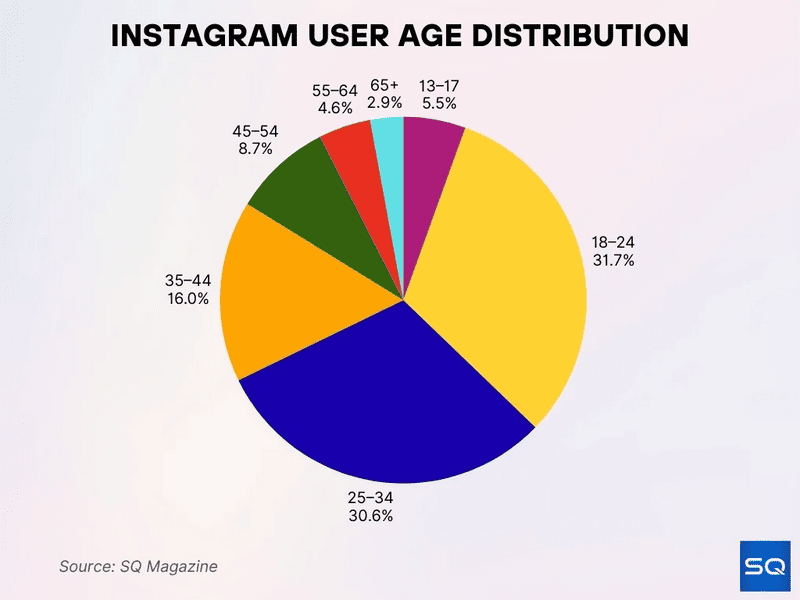
It’s been estimated that around 50% of U.S. adults use Instagram.
Instagram and Facebook each offer unique features that influence conversions in distinct ways.
The top three countries with the most Instagram users are the same as for Facebook: Instagram is most popular in India, the US, and Brazil.
The gender split on Instagram is virtually equal, with 50.6% of users being male and 49.4% female.
At inBeat, we see these demographics play out firsthand.
On Facebook, we’ve driven strong results for Hurom through dark posting campaigns.
We partnered with Chef Anna Machado (NFL player Nick Bosa’s personal chef) to share authentic product reviews paired with seasonal discounts. We also worked with The Metabolic Reboot Method to push direct conversions via targeted ads.
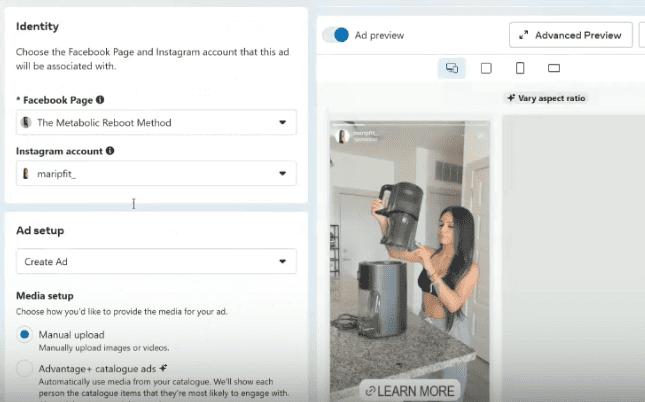
These campaigns worked especially well with Facebook’s slightly older, conversion-ready audience.
On Instagram, success looks different.
We run whitelisting campaigns with creators like Growing Your Greens, reaching health-conscious Millennials through ads delivered directly from influencer profiles.
We also lean into Instagram’s visual-first nature, using colorful, lifestyle-driven content that captures attention and drives engagement.
The bottom line: understanding where each demographic spends time and how they prefer to engage lets us create campaigns that genuinely convert.
Facebook leverages its Marketplace, detailed audience targeting, active Groups, and Reels to engage users. Facebook’s established reputation and trustworthiness make it ideal for B2B and high-ticket products.
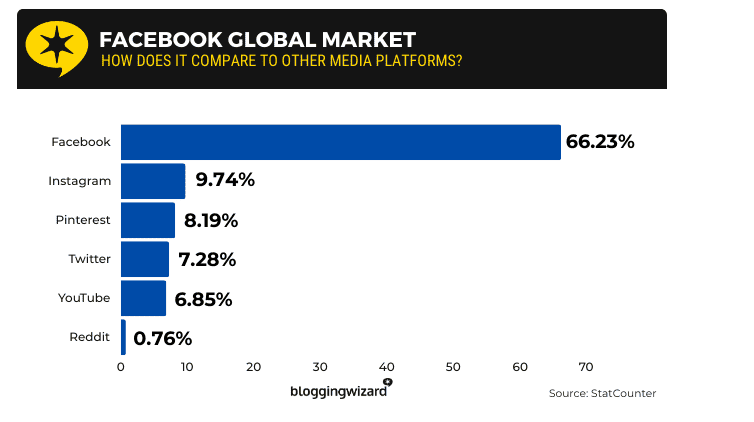
Facebook is a great choice if you want to precisely target customers and establish credibility. Research has shown that users are 63% more likely to trust news on Facebook.
However, Facebook and Instagram are on par when it comes to product recommendations and discovery, reaching 60-61% of people.
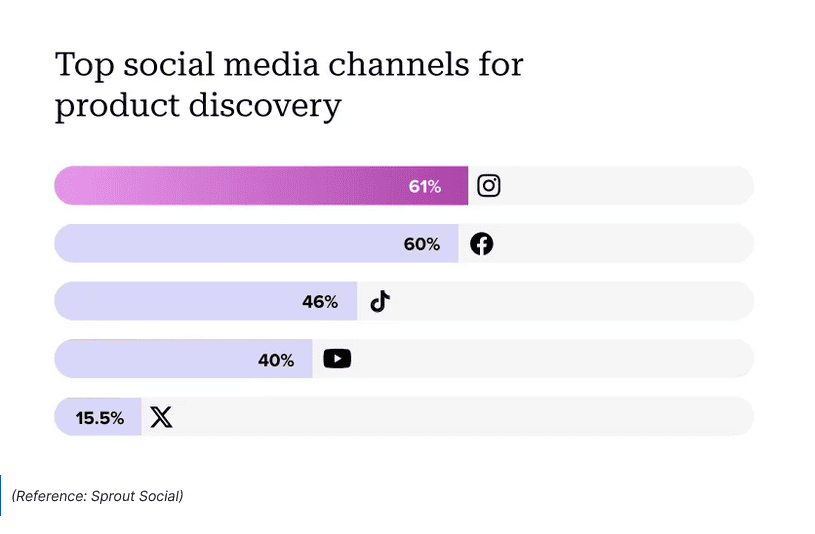
Facebook’s wide range of ad formats (feed ads, Stories, Reels, and even Marketplace) makes it one of the best platforms to drive ROI.
At inBeat, we use these formats to connect with your audience across multiple touchpoints, so you stay top of mind.
We also like that Facebook offers extensive demographic coverage and advanced audience segmentation. That’s very effective for capturing conversions in both the mid- and bottom-funnel stages.
Besides, we use the platform's detailed targeting and retargeting capabilities to make sure our campaigns connect with the right audience at the right moment.
This wide reach, precision, and trustworthiness make Facebook an essential tool for marketers seeking measurable and scalable results.
That’s why we recommend Facebook for B2B services, local businesses, and high-ticket products. In these cases, people don’t convert on impulse. They need multiple touchpoints, credible messaging, and precise targeting before they’re ready to buy. Facebook’s reach and retargeting tools make that process seamless.
Facebook’s biggest strength is how deep you can go with targeting. You’re not limited to age or interests. You can upload your customer list and build Custom Audiences, then create Lookalike Audiences to find people just like them.
You can also retarget anyone who visited your site, used your app, or engaged with your ads.
Other platforms offer similar features, but Facebook’s scale and maturity make them far more effective. Its audience pool is larger, the segmentation is more granular, and you can retarget across multiple placements without losing consistency. That’s why it’s such a strong choice for campaigns where conversions happen after multiple touchpoints
Facebook has some pretty impressive numbers when it comes to conversion rates. With an average conversion rate of 8.25%, Facebook consistently outperforms many other social platforms in direct-response advertising.
If you want to meet people where they already spend time, Facebook is still a strong choice. Unlike newer platforms that are trend-driven, Facebook has been part of people’s daily routines for more than a decade. That longevity builds familiarity, which makes users more comfortable clicking ads, sharing payment info, or engaging with brands.
Compared to Instagram, which leans heavily on lifestyle and discovery, Facebook tends to drive conversions when authority and reliability are key.
When customers feel part of a community and trust the brand, they are more likely to remain loyal, actively engage with content, and recommend products or services to others.
Facebook Groups and Pages provide structured spaces where users with shared interests can interact directly with each other and with brands.
Take Versed Skincare’s Good Skin Crowd on Facebook. It’s a private group where customers swap skincare tips, vote on product ideas, and share honest reviews. That back-and-forth gives the brand constant feedback and keeps people engaged between purchases.
This works because members feel heard. They’re not just buying a product, they’re part of shaping it. That sense of community builds loyalty and makes people more likely to recommend the brand.
As Melanie Bender, president of Versed Skincare, explained for Vogue Business:
“The goal with our data programme is always to empathise with our community, to know what they’re wanting and what they’re needing and what are their challenges because that lets us make the right decision. That might be the decision in an NPD [new product development] situation between formula A or formula B, but it also helps us make the right decision the next 50 times, because we have a better sense of what’s driving them [to purchase].” (Melanie Bender, president at Versed Skincare)
If your goal is quality over quantity, Facebook gives you tools to zero in on the right leads without paying LinkedIn prices.
The platform lets you combine demographic filters (like age, location, and education) with behavioral data (pages liked, purchase activity, and even device use).
This is especially useful in B2B when you need to reach decision-makers who may not spend their downtime on LinkedIn but are highly active on Facebook.
For example, a SaaS brand targeting mid-level IT managers can build a custom audience from its CRM list, then expand reach with lookalikes.
Pair this with retargeting to remain in front of prospects who have already engaged. That’s how you get higher-quality leads, lower wasted spend, and better conversion rates over time.
That’s what makes Facebook a smart play for B2B: you get LinkedIn-level targeting options, but with broader reach and more efficient costs.
Side note: That’s the theory. In practice, the right platform depends on the product and audience.
For Miro, the collaborative whiteboard platform, we leaned into Instagram instead for B2B influencer marketing.
We chose this channel so niche industry influencers could showcase their own dashboards and templates in a highly visual way.
Here’s a good example:
For them, Instagram’s creative-first environment drove more engaging B2B storytelling than Facebook ever could.
Even with all these advantages, Facebook marketing in 2025 still comes with a few challenges for businesses.
A major concern is Facebook’s declining younger audience. Gen Z increasingly prefers to spend their time on Instagram and TikTok. Facebook might not hold as much appeal for brands targeting this demographic.
And Facebook’s organic reach has been steadily dropping. The average engagement rate for Facebook posts is sitting at just 0.046%, according to RivalIQ.
To be fair, though, engagement rates have been dropping across all platforms throughout 2025. RivalIQ also notes the same thing.

But this doesn’t mean Facebook is a waste of your marketing spend.
Instead of giving up on Facebook, a better strategy for brands and businesses is to invest in paid campaigns to maintain visibility.
Although visibility also has a downside.
Ad fatigue is a major issue for Facebook. Audiences are repeatedly exposed to similar creatives, which means marketers need to continually refresh content to sustain engagement.
CPMs are averaging $8.17 and CPCs around $0.68. This can make campaigns expensive, especially for smaller businesses.
If you’re going to focus on Facebook, you’ll need to plan your campaigns carefully and allocate your budget wisely. With a good strategy and some creativity, you can get consistent performance and achieve measurable ROI from a Facebook marketing campaign.
Nothing beats Instagram when it comes to increasing engagement and discovery via visual storytelling. Instagram is where businesses bring products to life through engaging feed posts, dynamic Stories, and entertaining Reels.
That’s why 78% of global marketers use Instagram to get their message across.
Instagram’s interactive environment encourages creativity while building brand loyalty.
Features like shoppable posts, in-app checkout, and influencer collaborations make it simple for users to move from inspiration to purchase.
The data does show that Instagram’s direct conversion rates are lower than Facebook’s in some categories. But its ability to drive awareness, engagement, and top-of-funnel traffic makes it essential for brands in fashion, beauty, lifestyle, and creator-driven industries.
We’ve seen it thousands of times.
Companies that use Instagram strategically can feed audiences into retargeting funnels, increasing their overall ROI.
Now, let’s see those advantages in action.
Instagram’s feed, carousel, Stories, and Reels formats are great for creatively showcasing products. Used in the right way, these features can attract attention and drive engagement from users scrolling for inspiration.
Well put together Reels can achieve 22% higher interaction than standard videos. Stories have the potential to reach over 500 million daily users.
This matters for conversions because Instagram’s visual-first environment builds trust fast. Seeing products in real-life settings, through creators or user-generated content, makes people more confident to buy.
The platform’s format also encourages impulse decisions. A well-timed Reel or Story can nudge a user from “just browsing” to checkout in seconds.
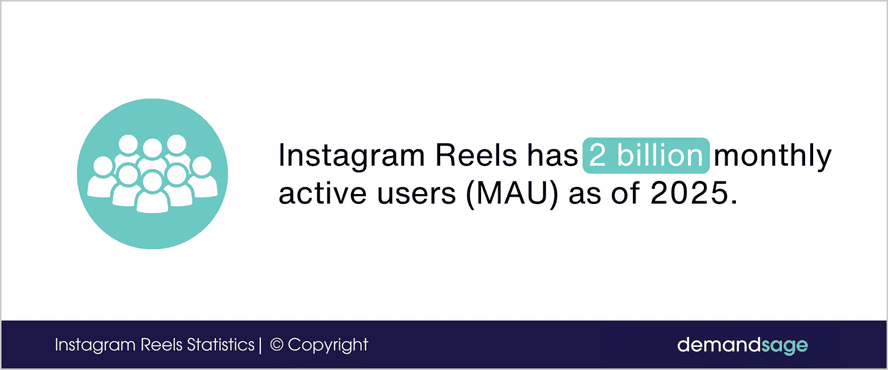
Instagram has an average engagement rate of 0.36%, according to the previous study we cited from Rival IQ. And we remind you that Facebook’s engagement rate per post across all industries was just 0.046%.

That’s why Instagram posts have a better chance to help brands spark interactions, encourage discovery, and foster long-term loyalty.
In our experience, Instagram’s visual-first formats push up its engagement rates.
Its Feed, Stories, Carousels, and Reels capture attention quickly and encourage interactions like likes, comments, shares, and purchases.
A host of interactive features make it easier for users to engage with content and explore products naturally. Features like shoppable posts, stickers, and in-app checkout reduce friction.
Instagram users are able to easily move from inspiration to purchase with a few clicks.
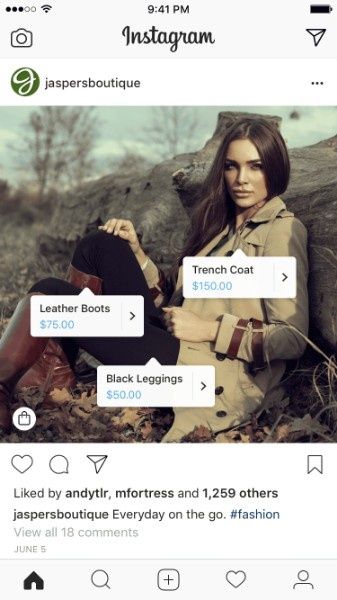
Instagram plays a powerful role in helping brands get noticed early in the customer journey. 61% of users discover new products via Instagram.
Its visually driven content and discovery-focused design drive top-of-funnel awareness. And that’s exactly what you need for more conversions.
Influencer partnerships and user-generated content are two of Instagram’s biggest conversion drivers. 30% of marketers cite Instagram as the top ROI platform for influencer campaigns. Besides, user-generated content can boost conversion rates by 4.5%.
Here’s a neat example from our client Native.
This beauty brand has a very stylish image, so they needed creators who regularly produce polished, on-brand content. At the same time, diversity is one of their core values.
So, we matched them with influencers from all walks of life: from Taekwondo world champion Leticia Esparza

to fashion stylist Prashant Yay.
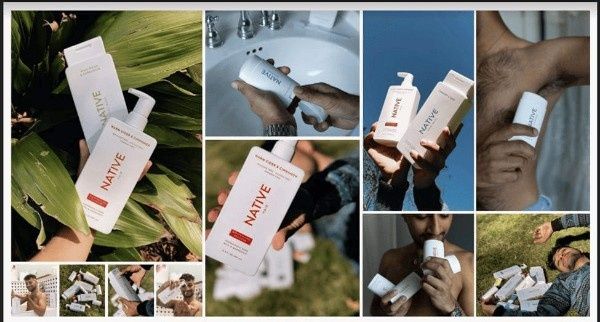
Why does this matter for conversions?
Because consumers trust content that feels authentic and relatable. Seeing real people (athletes, stylists, everyday creators) use a product builds credibility faster than branded ads alone.
On Instagram, that mix of polished aesthetics and authentic voices nudges users from admiration to action, turning engagement into measurable sales.
Instagram offers amazing opportunities to raise engagement and discovery levels. But it also comes with some noteworthy limitations for businesses.
The direct conversion rates generally lag behind Facebook’s 8.25% benchmark. Instagram may be a less reliable option for immediate sales in certain verticals.
Besides, competition on the platform is intense.
Most analysts estimate that over 25 million active businesses are vying for attention on Instagram. Standing out from the crowd can be challenging and often requires significant ad spend.
Visibility increasingly relies on paid promotion, and organic reach continues to be limited. You’ll need to invest in ads to maintain consistent exposure.
Instagram’s analytics and reporting are less granular than Facebook’s.
At inBeat, we see this gap every day. Instagram Insights gives you the basics: reach, impressions, followers, and engagement. For conversions, you have to jump into Meta Ads Manager, where Facebook offers deeper breakdowns and custom reports.
Third-party tools like Buffer also hit limits on Instagram data, especially for Stories and Reels. Facebook’s API is more open, so we get cleaner, more reliable data to optimize campaigns.
This makes it harder to optimize campaigns, track ROI, and measure detailed audience behavior.
Also, Instagram is primarily mobile-first and extremely visual-driven.
That’s great for lifestyle brands, but not every product fits into a quick-scroll, image-first format. If your offer needs detailed explanations or long-form content, Instagram isn’t always the best fit.
And if you only focus on conversion campaigns with hyper-narrow targeting, you risk missing Instagram’s real strength: discovery and long-term brand growth.
If you want to get the best results from your ad spend in 2025, you need to understand how Facebook and Instagram perform on conversions. Here's a comprehensive analysis of key performance indicators (KPIs) that influence decision-making:
With an average conversion rate of approximately 8.95%, Facebook is a strong platform if you’re looking to boost direct conversions.
In contrast, Instagram's average conversion rate ranges between 1% and 2%. Even the top-performing campaigns can only achieve up to 3%.
That’s why Facebook may be better at driving immediate sales while Instagram excels in brand awareness and engagement.
The Cost Per Acquisition (CPA) on Facebook varies by industry. Sectors like Food and Drink report a CPA of around $8.33, while Clothing and Accessories average $8.76. Instagram's CPA is generally higher due to increased competition and reliance on paid promotions.
Keep in mind: Instagram's Return on Ad Spend (ROAS) can be huge if you tap into influencer partnerships and shoppable features.
Facebook ads have an average Click-Through Rate (CTR) between 0.99% and 2.60%. Despite its visual appeal and interactive features, Instagram has a CTR of 0.83% to 1.61%.
Both platforms require strategic content to move users through the conversion funnel effectively. To drive engagement, you’ll need to come up with a compelling campaign.

Engagement rates on Facebook and Instagram have seen a decline. Facebook is struggling at 0.15%. Instagram fares a little better at 0.50%.
Instagram's higher engagement rate suggests a more active user base, which is great for brand-building and customer loyalty. On the other hand, Facebook's conversion rate indicates its superior strength in driving sales.
Social commerce is on the rise in 2025. 29% of Instagram users are making purchases directly through the platform. Facebook is projected to reach 80 million U.S. shoppers by 2025.
Both Facebook and Instagram are rolling out more shoppable tools, making it easy for people to shop without leaving the apps.
Here’s how these two channels stack up against each other:
Meta’s Advantage+ uses AI to handle targeting, testing, and budgets. This makes campaigns easier to manage and more effective. Even better, brands using it have seen a 5–8% boost in ad conversions.
Instagram’s TikTok-style Reels make it easier for brands to grab attention and drive interaction. With Meta’s AI pushing these videos to the right people, Reels now reach targeted audiences more effectively than before.
Social commerce is transforming the way people discover and buy products. With platforms blending content and checkout, businesses now have powerful new ways to drive sales. From shoppable posts to live shopping, learning how to tap into this growing trend is essential for businesses that want to sell smarter in 2025.
Choosing the right platform is key to reaching your audience and driving conversions. Here’s what we recommend:
If you’re going with the third approach, here’s how to make Instagram and Facebook work together for maximum impact:
Both Facebook and Instagram have unique advantages for marketers.
Facebook is great for precision targeting and has good credibility and high conversion rates. It’s a perfect space for B2B, local services, and high-ticket products.
Instagram, on the other hand, shines with visual storytelling, engagement, and social commerce. It’s the go-to for e-commerce, lifestyle, and creator-driven brands.
Because it drives fast, visually led conversions, it’s perfect for younger, highly engaged audiences and trend-driven or impulse sales.
Facebook excels for broader, lower-cost reach and deeper, trust-based conversion paths. So, it’s arguably better for considered, higher-value offerings.
You can also combine both platforms. Use Instagram to drive awareness and engagement. Then retarget audiences on Facebook for conversions.
With AI-powered Reels, shoppable content, and Meta’s ad tools, you can build a campaign that covers both immediacy and long-term ROI.
At inBeat, we’ve seen this dual-channel approach deliver consistent results across industries.
We’ll help you craft a personalized strategy that helps you reach your business goals, so get in touch today and let’s build Facebook and Instagram campaigns that actually convert.
1. Which platform is better for high-ticket B2C products and professional services?
Facebook seems to perform better for high-ticket B2C products and professional services because of its trust factor, in-stream video ads, and stronger targeting capabilities. Instagram is great for lifestyle and impulse buys, but Facebook usually converts better for purchases that require more consideration.
2. How do Facebook Feed ads and Instagram Stories ads compare for conversions?
Facebook Feed ads are effective for detailed storytelling and driving traffic, while Instagram Stories ads work best for quick engagement and mobile optimization. Stories are strong for fast actions, while Feed ads tend to generate steadier conversion data over time.
3. Is Facebook Reels good for performance marketing or just viral marketing?
Facebook Reels is no longer just about viral marketing. When you use lookalike audiences and have a clear ad optimization process, Reels can support performance marketing and lead generation while also building awareness.
4. What role does Cost Per Click (CPC) and Cost Per 1,000 Impressions (CPM) play in choosing platforms?
Instagram typically offers a lower CPM, which is useful for awareness campaigns. Facebook usually has a better CPC efficiency because of more advanced targeting. So, your budget reallocation should depend on whether your goal is reach or conversions.
5. Which company sizes benefit more from Facebook vs Instagram?
Smaller companies with tighter paid media budgets prefer Instagram for affordable awareness and organic reach. Larger company sizes with structured social media management teams tend to benefit from Facebook’s advanced performance monitoring, conversion data, and deeper ad optimization process.
6. How does brand personality and brand consistency affect conversions on social media sites?
Instagram is ideal for expressing brand personality with strong visual content creation. Facebook rewards brand consistency across in-stream video ads or reels. Brands that align messaging across both platforms usually see higher engagement and more lead generation.
7. What should a digital copywriter or marketer focus on when running ads across both platforms?
A digital copywriter should adapt messaging to the format. Instagram Stories ads need short, attention-grabbing lines, while Facebook feed ads perform better with slightly more detailed hooks. You also need to do careful performance monitoring and budget reallocation so your campaigns hit the right audience at the right time.